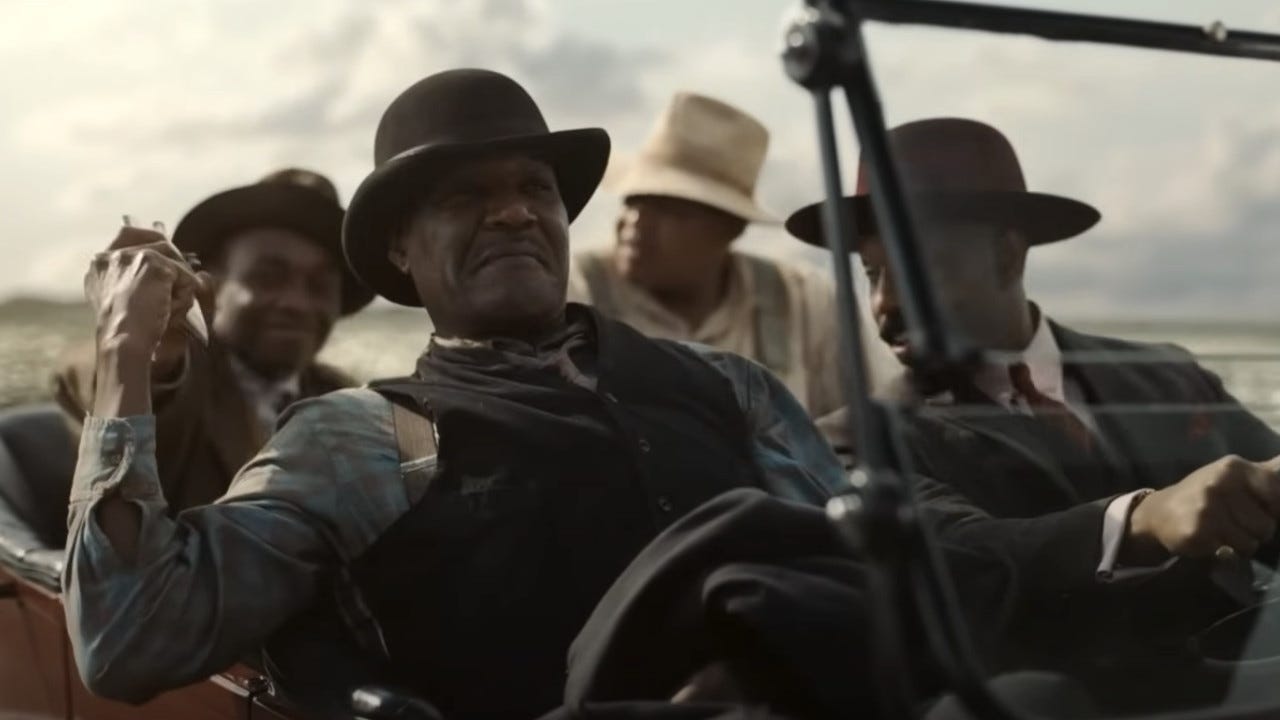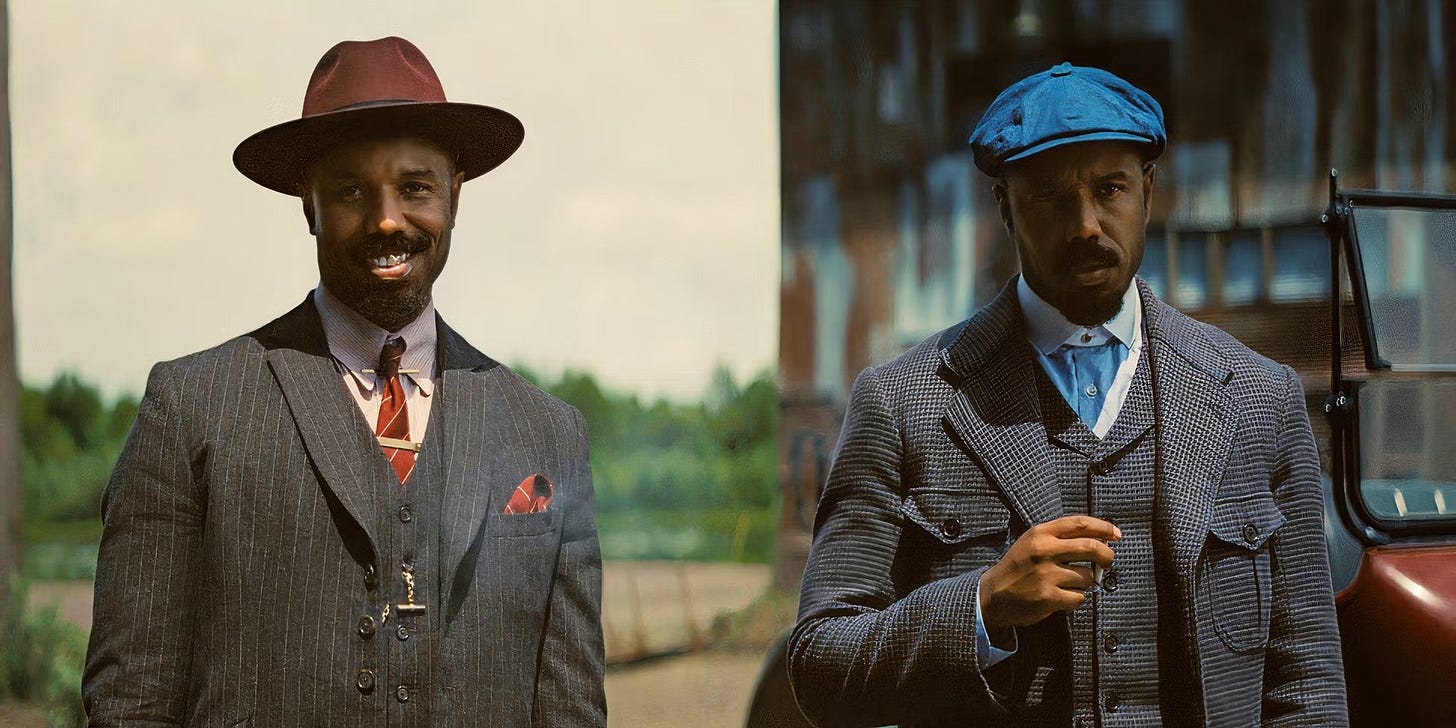‘Sinners’ and the Sturdiest Plot Structure Known to Man
‘Sinners’ does a lot of things right. One of the most important is its choice to put the band back together.
NEW STANDARD DISCLAIMER: This newsletter aggressively spoils things.
Sinners is a terrific film. It’s one of those sturdy, well-made movies that used to show up semi-regularly every year—the sort of films that didn’t redefine genres or reinvent the form, but are well-made in every sense1. Sinners has a lot of terrific ideas, inhabits a real-feeling fictional universe, and sports some banger performances from just about everybody involved. It is, in other words, way better than you’d expect a period piece vampire story that more or less shares a bifurcated nature with From Dusk to Dawn, which is not exactly a shining gem of cinematic greatness2.
Obviously, Ryan Coogler brought a high level of professional skill and creativity to the film, but there’s a primal reason why this movie is so creatively successful. Before you get to the epic charisma of Michael B. Jordan3 or the tight details that make the fictional universe feel so real, before the musicality4 and cultural richness and character-driven bits drive the story home, Coogler does one thing so right it makes the movie almost bulletproof: He uses what might be the most durable and error-resistant plot structure of all time5.
They Like the Blues Just Fine

Getting the Band Together shows up so often in stories we don’t even notice it. It’s invisible. We just sort of accept the fact that certain professions—criminal, mainly, but not exclusively—require that every successful group of professionals drift apart and have to be gathered up and repurposed every now and then. From Ocean’s 11 to The Blues Brothers to Dungeons and Dragons: Honor Among Thieves, plots that focus on gathering up the necessary members of a team almost always work—for the duration of that section of the story, at least. Once you have your inciting incident that puts the protagonist on the road gathering up their soldiers/pawns/partners/experts, everything just sings for a while. It’s almost impossible to screw it up6.
It works on a few levels. It makes introducing characters easy—you don’t have to explain why they’re showing up, because we went searching for them. It makes exposition easy, as the protagonist has to explain why they’re crucial. It makes world-building easy, because you have to travel around to find them, and get past various obstacles. Getting the Band Together offers so many advantages to the writer it’s little wonder it gets used so often.
Sinners uses it pretty brilliantly. Once the inciting incident (the Smokestack Twins [Michael B. Jordan] buying the old mill in order to open a roadhouse with their stolen alcohol) is behind us, they launch into a classic Getting the Band, driving around and picking up the key elements they’ll need to make the place into a success7. This sequence not only introduces us to the key characters of Sammie (Miles Caton), Cornbread (Omar Miller), Delta Slim (Delroy Lindo), Mary (Hailee Steinfeld), and Annie (Wunmi Mosaku), it offers us a tour of the setting. We see the folks working in the fields as sharecroppers, we see their homes and how they live. We meet the Chinese grocers Bo and Grace and see how they serve both the white and Black population. We observe how the whole universe works and relates to itself, but none of it feels like exposition, none of it feels forced8.
We Will Make Beautiful Music Together
Part of the beauty of a Getting the Band Together plot is how unforced it is. Introductions have to be made, absences explained, grievances aired. In other words, it’s a license to print exposition. In any other plot structure, all that jibber-jabber about past hijinks and current resentments would feel forced. But because we’re pulling everyone in for one last score, we’re under a time limit. Allowances are made9.
From a writer’s point of view, it’s honestly kind of a cheat code.
That doesn’t mean Sinners isn’t a very well-written film. Coogler’s a terrific writer, and his confidence as he builds this universe is impressive. Everything is a tool when you’re writing; all that matters is how well you use it. Getting the Band Back Together is a way of making exposition natural and non-obvious, and it’s a way of propelling your plot forward when the fundamental action isn’t all that interesting. I mean, the first half of Sinners is essentially about starting a small business10. If you showed Smoke and Stack making phone calls and paying invoices it wouldn’t be exactly riveting. But getting the band together? That always slaps.
And then, once the vampires show up, you can just cook11. You’ve already established your characters and your setting, so now you can introduce chaos in the form of a charming Irish jig-dancing undead monster12 and enjoy tearing those characters apart and that universe down. As a plot structure it’s so sturdy you’re going to see it about 5,000 more times in films, TV shows, and novels before you die13.
I never had a band to get together, sadly. Every time I suggested robbing banks or starting an actual band despite not playing an instrument my friends would just pat me gently on the head and buy me more drinks.
NEXT WEEK: Rick and Morty forgets what made it work.
If you enjoy this newsletter, consider subscribing to my paid fiction Substack, Writing Without Rules: From the Notebook!
This also describes my handsomeness.
Unless, like Quentin Tarantino, you’re a foot fetishest. In that case, it’s an absolute classic.
Movie star superpowers include making you imagine that if you met them in real life you’d be best friends and have adventures.
Having grown up with a father who like to get pissed and sing The Rocky Road to Dublin, this film 100% recontextualized that songs for me.
Take it from a writer who desperately needs all the error-proof techniques he can get his lazy, incompetent hands on.
The anti-example of this is the original The Italian Job, which just skips over the whole part about Charlie recruiting his team of criminals—except for the part where he recruits Benny Hill. And, frankly, that was the right choice.
It’s comforting to note that success in 1932 Mississippi is pretty much the same as today: Booze, music, and sweaty people.
Thank goodness there was no Vampire Expert character who bursts in and explains everything you need to know about the Rules of Vampirism. The characters just figure it out for themselves (or not), just like me when someone takes me to a fancy restaurant.
The greatest piece of writing advice ever given occurs in The Princess Bride: “No, there is too much. Let me sum up.”
The only thing missing is an extended sequence of Smoke and Stack being rejected by Chicago banks for a small business loan.
And let’s face it: In every single vampire story we’re all just waiting for the vampires to show up.
My ears are burning.
Unless, like me, you plan to have your consciousness transferred into a computer so you can watch eleventy billion AI-generated stories until the Sun swells up to consume us all.




Is "missed because it was so obvious" the title of my memoirs?
You bet.
https://x.com/PeterSeanBradle/status/1950243861718323290